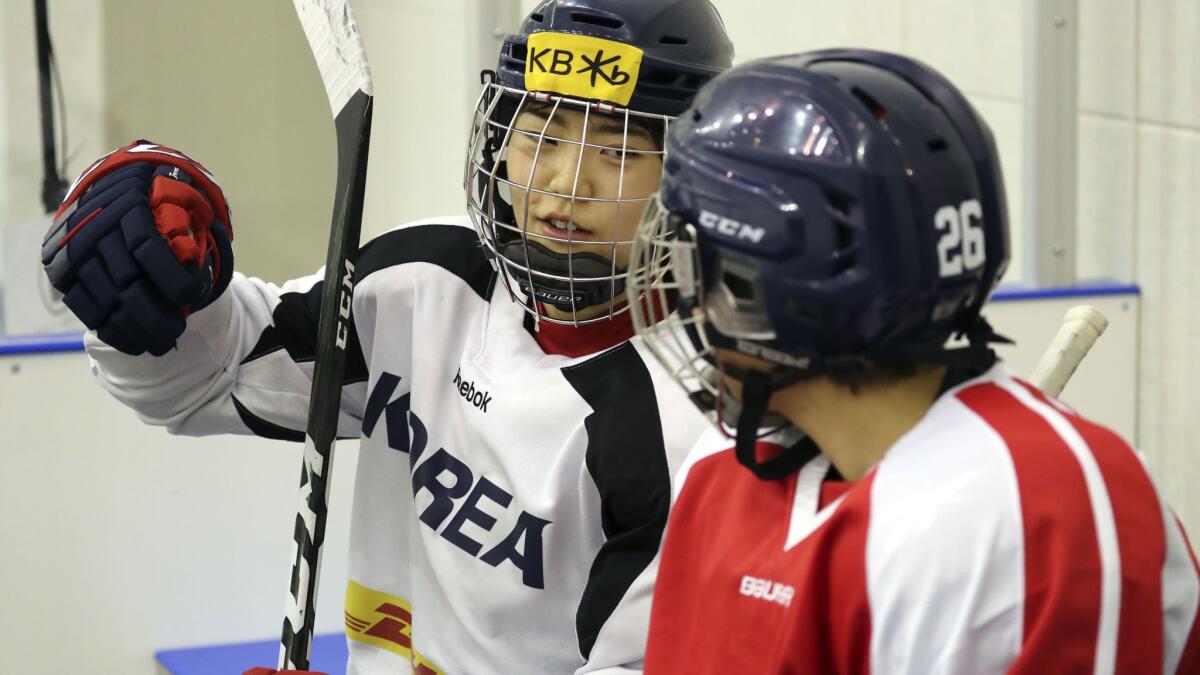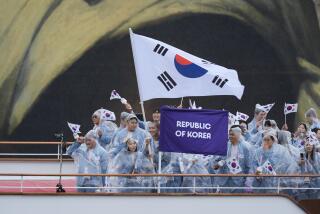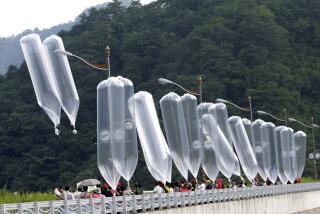Koreas’ unified women’s hockey team has exposed a key difference between South and North — their language

Reporting from Seoul — A dozen women’s hockey players from North Korea hit the ice for the first time with their new South Korean teammates this week, learning to compete as a combined squad just days before the Winter Olympics start.
Practice time is just one focus. They’re also still learning to talk about the sport together.
That’s because the shared Korean language spoken by the two nations — divided into the communist North and the capitalist South after World War II — has diverged in the last seven decades, just like their respective political ideologies.
Hockey is no different.
The Korean-speaking athletes from the South, like others in the Western-friendly nation, use English-influenced words in their postwar vocabulary. Those from the isolated North, however, lace up their skates while carrying a glossary of indigenous terms.
Take the “box out,” a term used for preventing opposing players from lingering near the net for rebounds.
South Koreans say “bagseu-aut,” a Korean-accented version of the English words that is foreign to North Koreans, prefer the more literal “munbakk-eu-ro mil-eonaegi” — or, “push out the door.”
That’s one of many examples, including the terms for “one timer” and “leg save” and “back skating.”
Despite these barriers, the players — the first combined Olympic team in any sport in Korean history — are learning to play together, organizers say. “They’re getting along just fine,” said Kim Jeong-min, a spokesman for the Korean Ice Hockey Assn.
Players from both sides do use perhaps the most common of shared words in hockey: “skate” and “puck.” But their coaches have had to address other linguistic hiccups with a cheat sheet of common terms needed to communicate on the ice. It lists numerous basic phrases that initially caused confusion among the players, who haven’t competed together until now.
Their first game, a friendly versus Sweden, is set for Sunday in Incheon, a city near Seoul.
The language differences are a linguistic consequence of the political divide on the peninsula, which has persisted amid an uneasy truce between North and South that stopped Korean War hostilities in 1953. Residents in both nations generally are prevented from crossing the heavily fortified border, and those in the North are restricted from consuming media produced in the South.
Much of their shared Korean language and alphabet, which traces its roots for centuries, has remained the same during the last seven decades. But significant parts of the vocabulary, grammar and pronunciations have changed.
The divergent language has been documented by linguists working on a common dictionary, and it also poses challenges for researchers and the tens of thousands of people who’ve defected from the North to the South since the war.
“I have to do a little on-the-job training for North Korean things,” said Curtis Melvin, an expert at the US-Korea Institute at Johns Hopkins University who has meticulously documented geography, government agencies and other institutions in the totalitarian North.
Melvin has taught himself to read and type the common alphabet for his work. He also has interns — many of them South Koreans — who get confused and amused by North Korean documents in ways both cultural and linguistic.
“The tone and the vocabulary and the imagery are all very striking to them, not just the language,” he said.
Researchers have documented the effects of the changes on communication among people from both countries, which have for the most part continued as adversaries while some still feel an instinctive tug toward unification of the peninsula.
One recent study by the National Institute of the Korean Language polled 200 people from the South — and 300 who defected from the North — who had experience communicating with someone from the other side. The study revealed that most of them could understand each other, generally, but that North Koreans struggled to comprehend South Koreans in situations where foreign-derived words were used.
Some immigrants from the North — who risk their lives to leave — face difficulty and discrimination in the South because they lack vocabulary or use differing dialects and accents. Others struggle with cultural assimilation that’s related to language, such as not understanding jokes or an unfamiliarity with pop culture references, said Lee Eunkoo, who co-founded an organization that helps defectors.
“One of the refugees we taught had the experience of being fired from her job at a bakery because she didn’t know the exact bread names, such as ‘baguette,’ ” said Lee, whose group is called Teach North Korean Refugees.
Three-quarters of the North Koreans said official terms in the South — like those for government, banking and medical interactions — were confusing.
“In the North, we try to use Korean in education and sports, whereas here they tend to just use the terms as they are,” said Ken Eom, a North Korean who defected to Seoul eight years ago.
In hockey, common phrases like the “butterfly style” — a technique in which the goaltender spreads out to protect the upper right, upper left, lower right and lower left portions of the net — can be confusing for the inter-Korean players.
North Korea’s players are likely to call it nabihyeong makki — literally “butterfly blocking.” In the South it’s called beoteopeullai — another Korean-accented interpretation of an English word.
Compounding the difficulty, the inter-Korean squad enters the Olympics with a Canadian head coach, Sarah Murray, who doesn’t speak Korean.
Murray, the daughter of former L.A. Kings coach Andy Murray, is relying on the South Korean manager and an assistant to translate her words to the players from the North, said Kim, the hockey association spokesman.
Even with more practice, the combined team wasn’t favored to compete for a medal at the Games, which open Feb. 9. But there is evidence that they can learn to communicate more like a national team as the competition progresses.
“The more South Koreans actually talk to North Koreans, the lower their discomfort will be,” said Park Seon, a researcher at the National Institute of the Korean Language. “More frequent communication and exchanges will diminish our discomfort with one another.”
Stiles is a special correspondent.
More to Read
Sign up for Essential California
The most important California stories and recommendations in your inbox every morning.
You may occasionally receive promotional content from the Los Angeles Times.











